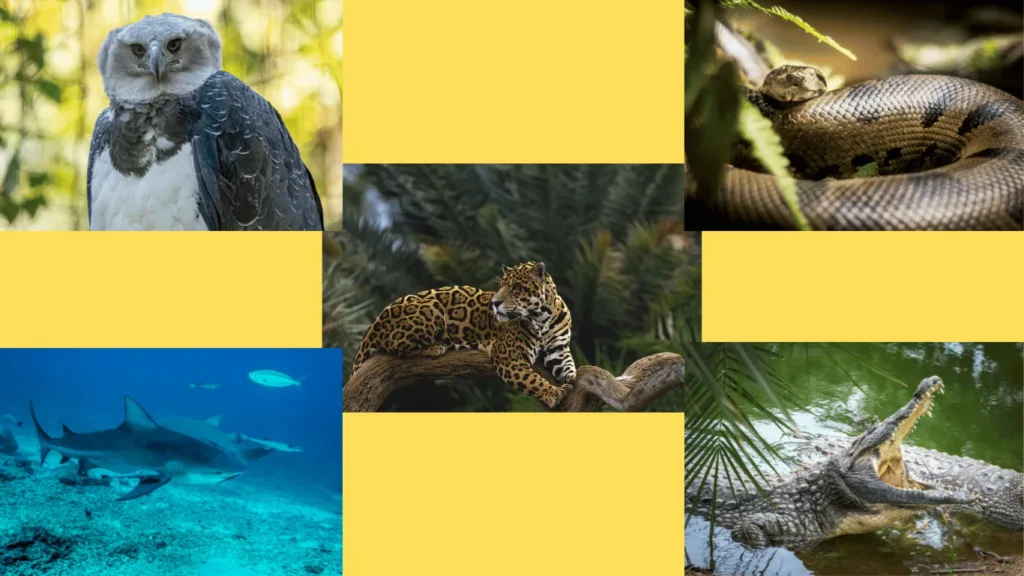
The tropical rainforest food web has a complex network of living things that depend on each other for food. Energy moves through this web, from plants to plant-eaters to predators.
The top predators in the rainforest food web hold the highest positions.
These include the tertiary consumers and apex predators. They are also known as the top 5 predators.
These top predators play critical roles. They help balance all the living things in the rainforest ecosystem.
The apex predators are at the top of the list of who eats who.
They use their strength and power to keep the natural balance. This supports the incredible diversity of life in the tropical rainforests.
Key Takeaways
- The food web in tropical rainforests is managed by a select group of apex predators known for their regulatory roles.
- Tertiary consumers are critical for sustaining the dynamic equilibrium within these rich environments.
- Predators are integral in preventing the overpopulation of certain species, showcasing the ecosystem’s delicate balance.
- Understanding the top predators is key to appreciating the full scope of biodiversity within tropical rainforests.
- Conservation efforts are vital to protect apex predators and, by extension, the health of tropical rainforest ecosystems.
Introduction to the Tropical Rainforest Ecosystem
The tropical rainforest contains rich and diverse life, with many types of plants and animals.
The hot, wet environment allows many living things to thrive. All these organisms fill essential roles in this complex ecosystem.
There are links between the rainforest plants and plant-eaters and the predators that eat them.
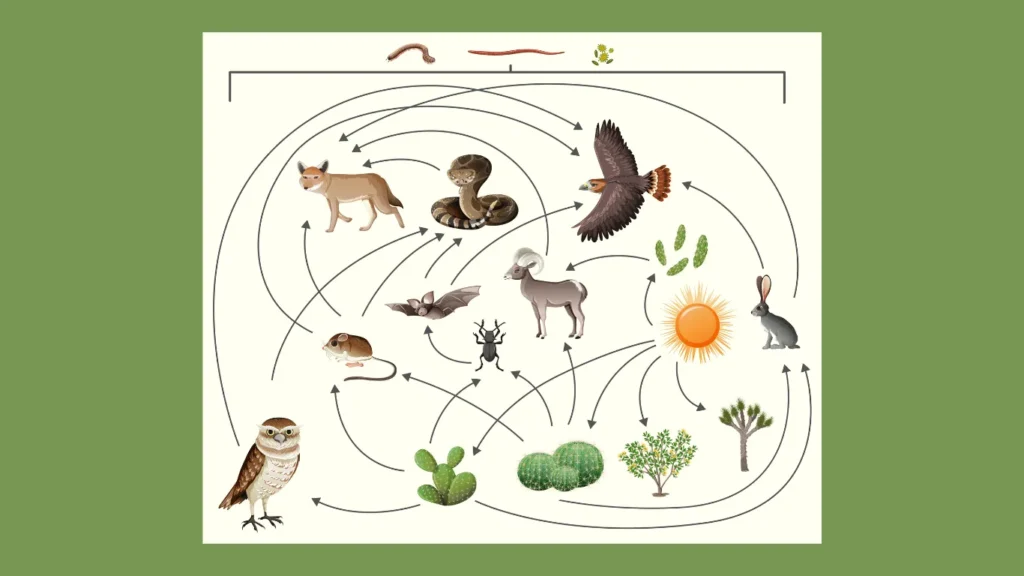
These connections, called food chains, show how rainforest life depends on each other.
Protecting rainforests is key to saving the many plants and animals worldwide.
Appreciating rainforests’ importance helps us understand their total value to Earth.
The rainforest ecosystem relies on intricate food web connections from organism to organism.
Maintaining Earth’s priceless biodiversity depends on the health of these critical tropical rainforests.
The Complexity of Biodiversity
Tropical rainforests have high biodiversity. They contain many living things, from tiny microbes to massive trees and hard-to-find big cats.
Rainforests draw scientists and nature experts seeking to study the complex networks between organisms.
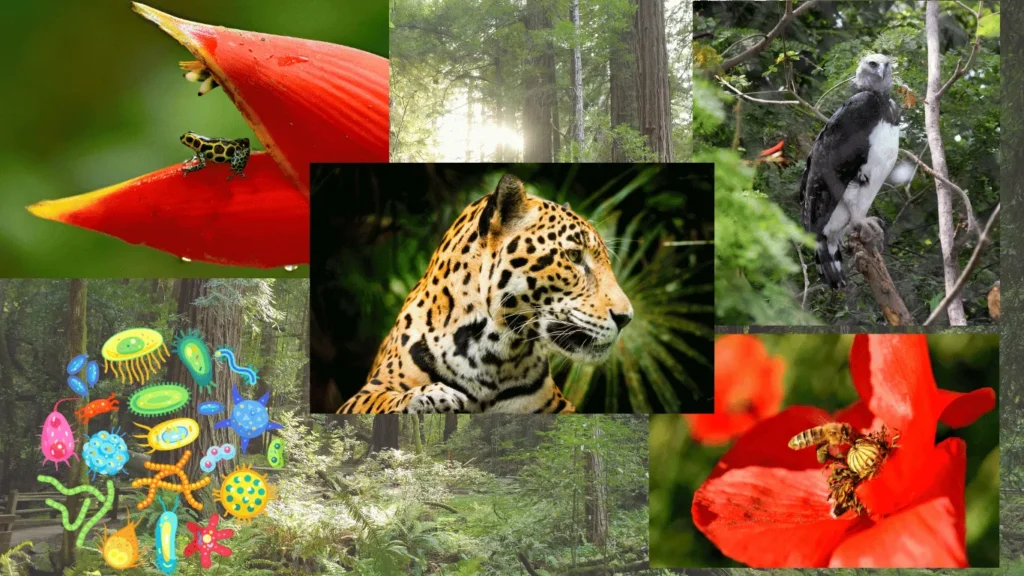
All creatures have a role, from those that break down waste to the top predators.
Every plant and animal shows the beauty of evolution through the variety and complexity of rainforest life.

The connections display how each depends on the others to survive.
Safeguarding these rare habitats protects the intricate webs that uphold Earth’s precious biodiversity.
Each plays an irreplaceable part in the tropical rainforest’s fabric, from jaguars to tree frogs.
Roles Within the Rainforest Food Web
Complex rainforest food chains happen in the shaded forest bottom and sunny top layer.
Materials and energy move through living things. One organism depends on another to live.
Like slow sloths munching leaves and colorful parrots breaking nuts, plant-eaters connect the plant kingdom. They become food for meat-eating predators.

Every animal has a role, from tiny ants to sneaky wild cats.
They balance numbers and nutrient flows in the rainforest’s interconnected web.
The magnificent cooperation between rainforest life forms an intricate food web.
This links powerful jaguars to delicate butterflies, upholding the health of the whole system.
Conservation Importance of Tropical Rainforests
Rainforests may look like they have endless plants and fertile soil. But they face threats from human use and growth.

Protecting these spaces involves more than saving the many amazing animals living there.
Tropical rainforests also filter bad air and make oxygen, like the planet’s lungs.
They absorb large amounts of carbon, slowing climate change.

Safeguarding rainforests maintains the natural balance that allows diverse life to thrive. It also ensures clean air and a stable climate worldwide.
Preserving these unmatched habitats through conservation is critical. Healthy rainforests support everything from jaguars to trees that provide Earth’s oxygen.
Their care protects species, ecosystems, and our global climate.
The Foundation of the Food Web: Producers
The foundation of the busy rainforest ecosystem is the green plants.
Through photosynthesis, these rainforest food chain producers start the energy flow that supports all life.
Many plant types like bamboo, banana, and coconut trees use sunlight in the thick forests.
They make the organic matter that feeds a variety of living things.
The plants form the base on which the entire Tropical Rainforest Food Web depends.
Complex networks of herbivores and carnivores rely on humble leaves’ ability to turn sun into sustenance.
Bamboo trees – known for their rapid growth and versatility, bamboo stands tall as a crucial resource for many herbivores in the understory.

Banana trees – with fruit rich in nutrients- are frequented by various species, from tiny insects to large mammals.

Coconut trees – towering above the forest floor, the coconut tree provides sustenance and habitat, its fruits being a favored meal in the animal kingdom.

These green plants give food and make oxygen-filled air, which rainforests are known for.
Producers like bamboo, banana, and coconut trees connect the sun’s energy to the living things in this environment.
They supply more than just food. The plants form the base that the interconnected rainforest food web depends on.
The rainforest’s rich biodiversity relies on photosynthesis, from towering trees to tiny fungi.
This process turns light into nutrients, sustaining the web of life spanning jaguar to ant.
Primary Consumers: The Herbivores
The complex living connections in the rainforest depend on varied plant-eating animals.
These herbivores link the sun-powered plants to other life forms up the food chain.
The plant eaters range from tiny bugs to some of Earth’s grandest mammals.

They all live together in the dense leaves and unique rainforest vegetation.
From minute mites to towering giraffes, the rainforest’s array of herbivores allows energy to flow.
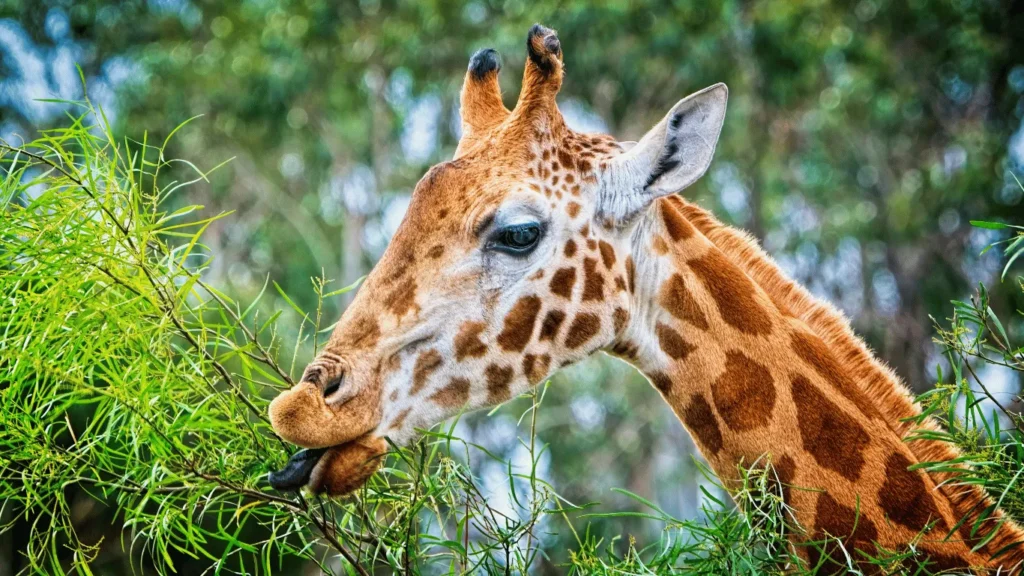
They eat leaves and fruits to survive and play a crucial role in the intricate rainforest food web.
Unique Flowering Plants and Their Consumers
The lovely flowering plants in the wide variety of rainforest plants are unique. Their bright colors not only look nice but help feed plant eaters.

These flowers have evolved clever ways to use the animals. Sweet nectar brings certain insects or birds that spread pollen.
Fruits lure animals to eat berries and then drop seeds far away.
The intricate ties between beautiful blossoms and the living things that rely on them showcase the rainforest’s complex web of life.
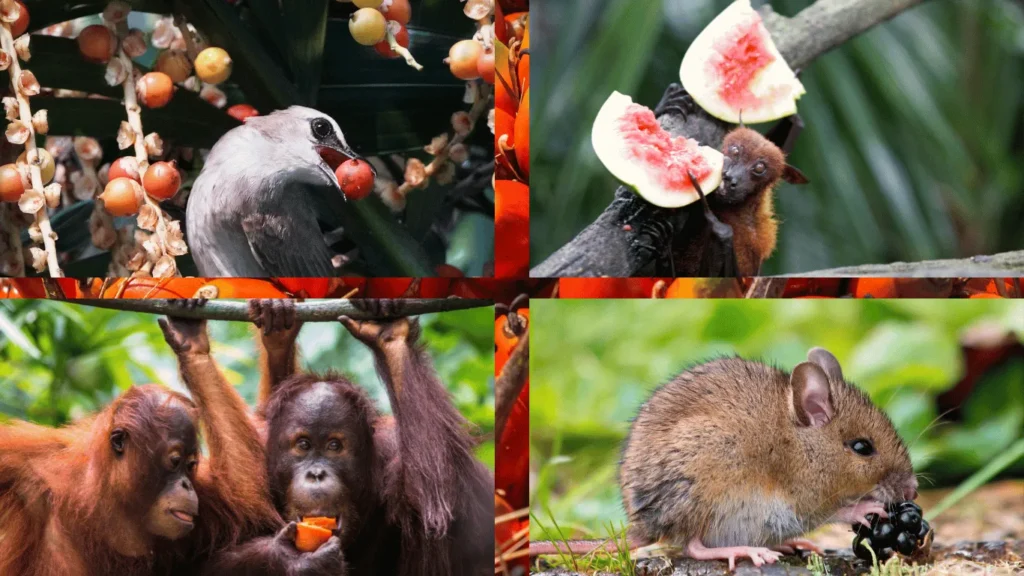
This interdependence sustains both the plants and numerous herbivores.
Role of Fruit Bats and Small Lizards in the Food Web
Fruit bats and small lizards serve as vital cogs in the food web machinery.
As main plant-eaters, fruit bats spread seeds, key to shaping the rainforest layout.
Small lizards manage bug numbers by eating many plant-harming insects. This protects plants from too many attackers.
Creatures like fruit bats and lizards hold vital jobs keeping balance as primary rainforest consumers.
Their place on the food chain maintains plant diversity, sustaining the entire ecosystem.
Even small species carry weight through intricate connections.
Vegetation General Geographic Features and Their Plant Eaters
The distinct general geographic features of tropical rainforest vegetation support various herbivores.
The fertile ground grows thick plants on the forest floor.
Higher up, tall treetops have abundant leaves, fruits, and flowers. These spots let all types of plant eaters flourish.
The rainforest’s many layers offer perfect places for varied herbivores.
This allows plant nourishment to support chains reaching up to mighty jaguars.
Secondary Consumers: The Small Predators
Secondary consumers emerge as critical players within the intricate tapestry of tropical ecosystems.
These smaller animals are varied nonplant eaters.
They include quick bugs, flexible birds, and tiny mammals.
Their key food chain job links plant-eaters at the bottom to top predators.
Creatures like clever insects and squirrels hold middle roles carrying energy up the web.
Though small, they enable herbivores and jaguars to fill niches across the tropical rainforest.
The Intermediaries: Insects, Birds, and Small Mammals
These middle predators form the food web’s backbone. They move energy from low plant-eaters up the chain.
Across all layers, insects like praying mantises and beetles hunt prey. Birds of prey soar overhead, scanning for food.
Small mammals like mongooses and tree shrews snuffle through dense leaves finding snacks.
The rainforest depends on these species as essential energy conduits.
Squirrels, hawks, and ants enable the flow between photosynthesis beginnings and apex jaguar endings.
Each plays an irreplaceable role in a balanced Tropical Rainforest Food Web.
Importance of Secondary Consumers in Tropical Ecosystems
- Regulation of primary consumer populations, preventing overgrazing and plant depletion.
- Maintaining the balance of species ensures that no one group dominates the habitat.
- Facilitating energy flow between trophic levels is vital for ecosystem vitality.
Human Predation Impact on Secondary Consumers
Though versatile, these key secondary consumers face major threats from human predation.
Overhunting and habitat harm reduce their numbers. This disrupts the whole food web.
As human activities pressure predators of smaller animals, their ecological jobs weaken. This starts ripples across the rainforest.
These species’ future links to broader environmental problems. Saving them maintains healthy habitats.
More on conservation ideas and why biodiversity matters in tropical areas can be found in related articles.
Safeguarding rainforest insects, birds, and mammals protects more than one species. It upholds connections vital for Jaguars, trees, and all between to survive.
Losing even small cogs like beetles risks collapsing this complex food web.
Tropical Rainforest Food Web: Tertiary and Apex Consumers
In the tropical rainforest food web, top predators like big cats and birds of prey play key roles in balance.
These strong hunters form the food chain’s highest level, managing plant eater and meat eater numbers so all species thrive.
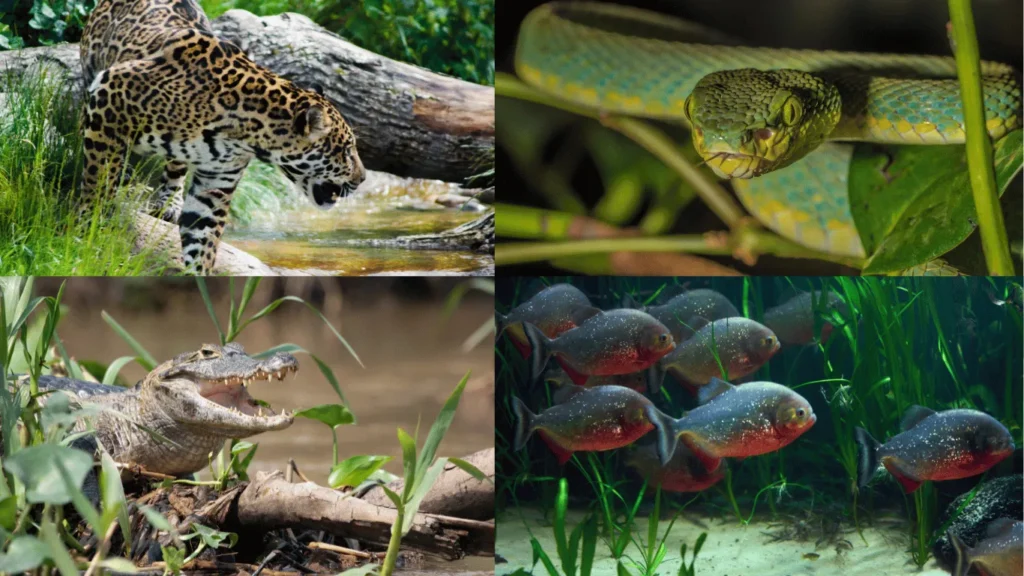
Evolved to stalk and catch tricky prey, they control mid-level life forms.
This prevents over-grazing so plants stay healthy, impacting many links at once.
Additionally, these apex predators manage smaller meat-eaters through regular hunting. This curbs disease spread among their typical prey.
Mighty jaguars and soaring eagles sit atop the Tropical Rainforest system.
By overseeing diverse populations, they uphold equilibrium, allowing monkeys, sloths, and endless organisms to fill niches.
- Contribution to biodiversity maintenance
- Regulation of lower trophic levels through predation
- Containment of herbivorous populations, preventing overconsumption of vegetation
Top jaguar and eagle rainforest predators do more than hunt.

They influence habitats by spreading seeds from fruit and making room for specific plant growth needed for the whole forest.
Their wide-reaching functions and parts in the Tropical Rainforest involve indirect ecosystem impacts beyond catching prey.
Even their bathroom habits help some trees flourish, benefiting the enormous biodiversity relying on specific niche spaces.
The Big Cats of the Rainforest
Inside the vast Amazon rainforest, the grace and power of big cats show why they rule as top hunters.
Sneaky jaguars and leopards have solid bodies and sharp senses, representing the wilderness and complex connections.
These cat predators are key to balancing many types of life where they live. Their story is about staying strong and in control so the most able carry on.
Legendary jaguars prowl the dense jungle as testaments to survival adaptation.
By persisting as apex consumers over eons, they showcase the rainforest’s boundless biodiversity framework enduring alongside Earth’s mightiest hunters.
Large Carnivores: Jaguars and Leopards
As central rainforest players, jaguars and leopards rank among the Amazon’s most formidable hunters.
Their incredible stalking and killing abilities curb plant-eater numbers, preventing anyone from taking over.
Though hard to spot night and day, signs remain that reveal their ecosystem role.
As critical main parts of the food web, their prowess manages herbivore expansion.
By quickly dispatching agoutis to tapirs, Jaguars ensure endless niche availability for sloths, frogs, and all who depend on diverse plant life.
Apex Predators’ Role in Controlling Herbivore Populations
Top rainforest hunter is not just a name for big cats. It’s the vital role jaguars and leopards play in the Amazon.
Preying on diverse plant eaters stops over-grazing, so more trees and plants grow.
This balance between predators and prey keeps the rainforest healthy.
Without it, the whole structure could collapse, putting many animals at risk of disappearing.
As enduring apex predators, legendary jaguars and elusive pumas help manage herbivore populations across the levels of the rainforest food web.
Their presence upholds the equilibrium, allowing sloths, monkeys, and tapirs to fill feeding niches without destabilizing the system.
As agents of natural control, these large carnivores are instrumental in sustaining the health and vibrancy of one of the planet’s most biodiverse regions – the great Amazon rainforest.
Crowned Eagles and Green Anacondas: Aerial and Aquatic Predators
Beyond land-ruling big cats, rainforests have top hunters in the trees and waters.
In the air, mighty crowned eagles prey on monkeys and sloths.

Slipping through murky rivers, green anacondas snatch unwary creatures.

These royal birds and sneaky snakes manage prey numbers, showing the wonder and intricacy of the hot, wet environment.
From the emerald canopy to the winding tributaries, the rainforest harbors specialist hunters wielding evolutionary mastery.
Ferocious harpy eagles and patient anacondas uphold the dynamics enabling diverse rainforest creatures to fill feeding roles across the verdant ecosystem.
Majestic Birds and Stealthy Serpents
With powerful grace, mighty crowned eagles rule the skies as specialized raptors adapted for rainforest life.
Their sharp eyes spot prey below, swooping to strike. This shows one peak bird predator.
In contrast, sneaky green anacondas hide in water, embodying the patient ambush skills of serpents.
Both finely-tuned hunters use their abilities to make up central functions parts, keeping balance in their home ecosystems.
These apex experts manage communities from the canopy heights to the winding rivers.
Dominant eagles and lurking anacondas uphold stability, enabling diversity across the intricate rainforest food web levels.
Functions and Parts They Play in the Food Web
Crowned eagles and green anacondas are key managers in the food web system. As top hunters, they limit prey numbers.
This stops plant-eaters from destroying all plants and keeps smaller predators in check.
Controlling species is vital so the rainforest stays diverse and each organism stays strong.
The balance from these hunters shows the interdependence binding all life here.
Every rainforest creature relies on the population dynamics sustained by apex specialists, from sloths to monkeys.
Soaring raptors and winding snakes enable all below them to fill feeding roles, upholding equilibrium across the rainforest ecosystem.
- Crowned eagles control arboreal mammals, influencing the seeds’ dispersion and the forest canopy’s growth.
- Green anacondas dominate aquatic and riparian zones, regulating fish, capybaras, and caimans.
Ultimately, the rainforest’s top eagles and anacondas show hunting’s broad impact.
Learning their jobs reveals each soaring wing or watery coil aids the vibrant habitat more than expected.
Every movement maintains the biodiversity that makes tropical forests globally unique.
From ferocious beaks to fang-lined jaws, apex individuals like crowned eagles and bushmaster snakes uphold intricacies that enable life to flourish.
Their presence preserves equilibrium across the rainforest’s complex food web for countless creatures to fill roles.
Conclusion
As we explored the hot, wet rainforest layers, the complex interdependence in the food web became clear.
This system is vital for global biodiversity.
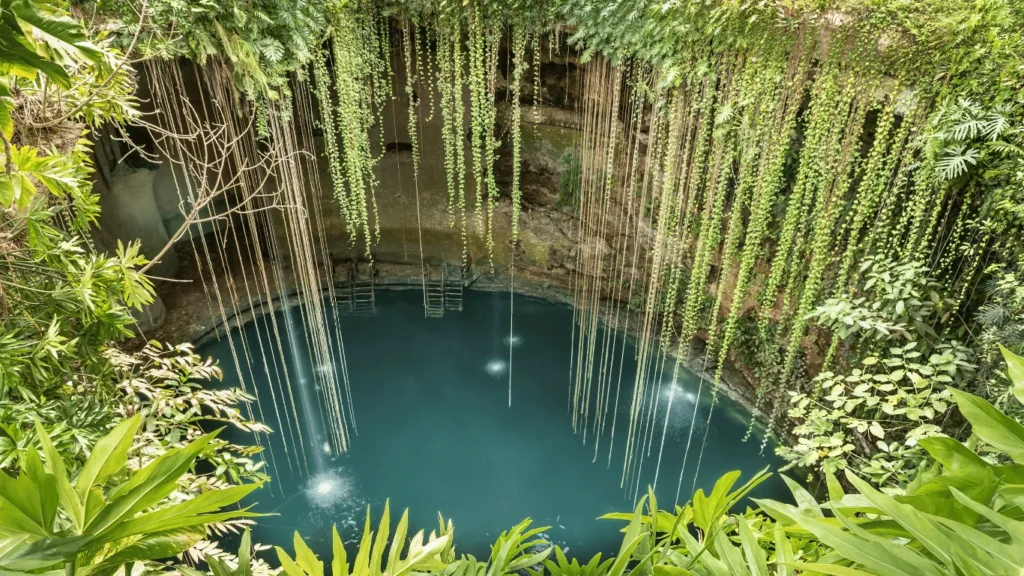
Every top predator, from sneaky jaguars to towering eagles, keeps balance.
Losing one animal risks unraveling connections, showing why saving each extraordinary species matters.

Protecting them sustains all rainforest life.
Safeguarding critical habitats through conservation maintains stability.
Threats like deforestation, climate shifts, and overhunting also endanger food webs. Realizing these links shows why protection is key.
Our rainforest trek ends with a call to learn and act. More research and awareness globally are essential.
As Earth’s caretakers, we must ensure thriving rainforests.
Understanding and sharing rainforest knowledge supports good choices to shelter their unmatched and interwoven wonders.